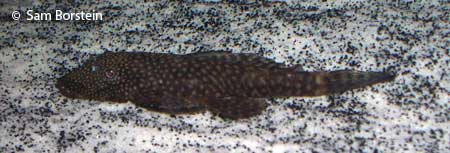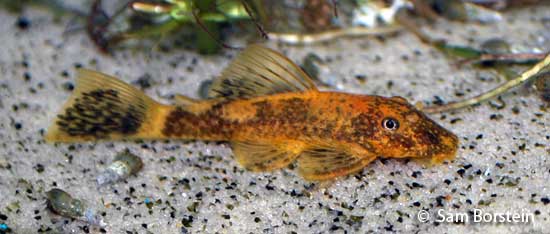Ancistrus cirrhosus
(Valenciennes, 1836)
Common Bristlenose Pleco
Synonyms: Ancistrus sp. "3", Ancistrus sp. "Bristlenose Pleco"

Above: A female Bristlenose Pleco. Photo by Sam Borstein.
Etymology:
Genus- Ancistrus= fish hook (Greek). In reference to the spikes on their fins.
Species- cirrhosus= fringed (Greek).
Intro:
The Dwarf Bristlenose Pleco is by far one of the most popular fish in the aquarium hobby. It is easily attainable, easy to care for, useful, and relatively active in the aquarium. This fish is one of the best algae eaters available on the market.The fish is also line bred a lot, causing a wide variety of flavors:
- Classic Brown
- Albino
- Calico
*NOTE*: All of the above color types come in standard or longfin form.

Above: A line bred Calico Bristlenose Pleco. Photo by Sam Borstein.
Distribution:
This fish is found in rivers throughout South America.
Size, Maturity, and Sexual Dimorphism:
Size: Males- 5 inches, Females- 4.5 inchesMaturity: 2.5 inches
Sexual Dimorphism: Males are larger and have bristles on the face.
Care:
Bristlenose Plecos are really easy to care for. They accept pretty hard, basic water, and do fine in soft, acidic water. The tank should be good sized, with caves and tight crevices for the fish to hide in.
Bristlenose Plecos will come out in the day, and spend most of their time on the glass, eating algae off it. You can keep this fish with tetras, livebearers, and some cichlids. You may not want to keep this fish with substrate spawning cichlids as they may eat their eggs. Large aggressive Central and South American should not be kept with Bristlenose Plecos as they can tear them to shreds.
Diet:
Ancistrus cirrhosus is an herbivore. You should give it a diet of spirulina wafers, and other vegetable matter. They are also scavengers, and will eat uneaten food. I have found mine to even eat the small Malaysian trumpet snails. As a treat you can offer them zucchini once a week, which they really enjoy.
Breeding:
Ancistrus cirrhosus is pretty easy to spawn. It takes a while for the fish to be sexually mature, but they eventually should pair up.
This fish is a cave spawner and prefers spawning in tight cracks between rocks and in crevices. The male guards the clutch off eggs the female lays! The eggs take about 1 week to hatch and will stay in the spawning site with the male for another 5-7 days. They fry are about 1/4-1/3 of an inch long.
I believe the spawn ratio of males to females in this fish is temperature sensitive. My spawns tend to be 90% female, and 10% male. There is also a chance it is due to pH.
New born Bristlenose are great algae eaters and a group of fry can clean a 10 gallon tank covered in algae in 1-2 days.
Conclusion:
If you need an algae eater the Bristlenose Pleco fits the bill. It is very easy to keep and to obtain. The basic types are not very expensive either, being $3-$4 dollars apiece. This fish is welcome aquarium resident.
References:
- Seidel, I. (2008) Back to nature guide to l-catfishes. Fohrman Aquaristik, Sweden, 208 pp.
